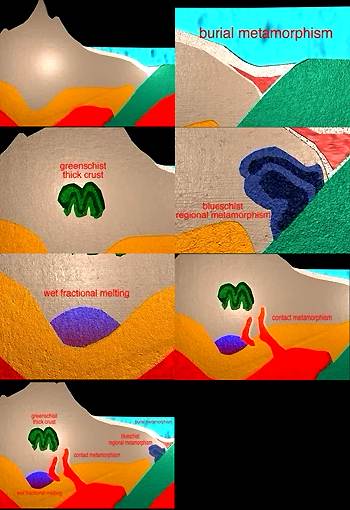When an intrusive magma first makes contact with a limestone, the limestone immediately at the contact zone can be forced to release its water very rapidly. This fluid may cause local chemical reactions through a solution process that will not be available to limestone only marginally further away.
Metasomatism (meta="change", soma="juice" ... Latin this time) is then the very reactive metamorphic change caused by this super hot fluid near the contact zone. This fluid can concentrate any minerals that are more soluble in water and hence it can produce localized concentrations of them. They are also called "hydrothermal solutions", and are responsible for creating important ore deposits.
Today these processes continue along the western coast of much of North America and much of the western coast of South America.

1.) Burial metamorphism is believed to happen at the base of the large piles of sediment on the continental - ocean boundaries and in the deep trenches. Low temperate and low pressure make this low-grade metamorphism.
2.) Regional metamorphism occurs at the upper subduction zone when a sinking ocean crust contacts and deforms the continental crust. Increasing pressure happens rapidly, but there is still not high temperature. This region is in the high pressure end of low-grade metamorphism. Formation of blueschist.
3.) Regional metamorphism with higher temperature. This type occurs at depth under thick continental crust. This type of metamorphism runs form the high end of low-grade to true high-grade metamorphism. Formation of greenschist.
4.) Wet fractional melting begins to happen at the base of continental crust. Here conditions are proper for true high-grade metamorphism and borders on the conditions necessary to create a magma.
5.) Contact metamorphism can occur anywhere that hot magma contacts a country rock. There are very high temperatures at the contact region and there are usually medium high to high pressure depending on the burial depth. This too is a region of high-grade metamorphism based on temperature but not necessarily on pressure.
| NEXT | TOC | PREV |